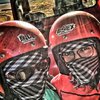Research papers published on the use of Near-infrared spectroscopy in the field of virology
[Also outlined with links to the full articles at the end of my weblog post here: https://hefnawi.me/posts/detect-sars-cov-2-near-infrared-spectroscopy/]
- Santos, M.C., Morais, C.L., Nascimento, Y.M., Araujo, J.M. and Lima, K.M., 2017. Spectroscopy with computational analysis in virological studies: A decade (2006–2016). TrAC Trends in Analytical Chemistry, 97, pp.244-256.
- Sakudo, A., Tsenkova, R., Onozuka, T., Morita, K., Li, S., Warachit, J., Iwabu, Y., Li, G., Onodera, T. and Ikuta, K., 2005. A Novel Diagnostic Method for Human Immunodeficiency Virus Type‐1 in Plasma by Near‐Infrared Spectroscopy. Microbiology and Immunology, 49(7), pp.695-701.
- Fernandes, J.N., Dos Santos, L.M., Chouin-Carneiro, T., Pavan, M.G., Garcia, G.A., David, M.R., Beier, J.C., Dowell, F.E., Maciel-de-Freitas, R. and Sikulu-Lord, M.T., 2018. Rapid, noninvasive detection of Zika virus in Aedes aegypti mosquitoes by near-infrared spectroscopy. Science advances, 4(5), p.eaat0496.
- Kobayashi, T., Kato, Y.H., Tsukamoto, M., Ikuta, K. and Sakudo, A., 2009. Portable visible and near-infrared spectrophotometer for triglyceride measurements. International journal of molecular medicine, 23(1), pp.75-79.
- von Lühmann, A., Herff, C., Heger, D. and Schultz, T., 2015. Toward a wireless open source instrument: functional near-infrared spectroscopy in mobile neuroergonomics and BCI applications. Frontiers in human neuroscience, 9, p.617.
- Rinnan, Å., Van Den Berg, F. and Engelsen, S.B., 2009. Review of the most common pre-processing techniques for near-infrared spectra. TrAC Trends in Analytical Chemistry, 28(10), pp.1201-1222.
- Marques, A.S., Moraes, E.P., Júnior, M.A., Moura, A.D., Neto, V.F., Neto, R.M. and Lima, K.M., 2015. Rapid discrimination of Klebsiella pneumoniae carbapenemase 2–producing and non-producing Klebsiella pneumoniae strains using near-infrared spectroscopy (NIRS) and multivariate analysis. Talanta, 134, pp.126-131.
- Sakudo, A., Suganuma, Y., Kobayashi, T., Onodera, T. and Ikuta, K., 2006. Near-infrared spectroscopy: promising diagnostic tool for viral infections. Biochemical and biophysical research communications, 341(2), pp.279-284.
This project is NOT affiliated to any organisation, team or group of individuals!
 Ahmed Hefnawi (Volta)
Ahmed Hefnawi (Volta)




Ahmed Hefnawi (Volta) currently i am going to participate in a hackathon and i have been working on the similar idea also .
Currently my team is trying to analyze by bioinformatics tool the optical symmetries , as u know that already the virus is proved to be Raman positive and detected in a very well manner ; so there is a chance that it may be positive for IR or may not based on molecular rather centroid symmetry.
Data is very much needed by experiments on known positive samples with IR spectrometer and then we should try to minimize the cost and size of the spectrometer and the Deep neural network for interpretation